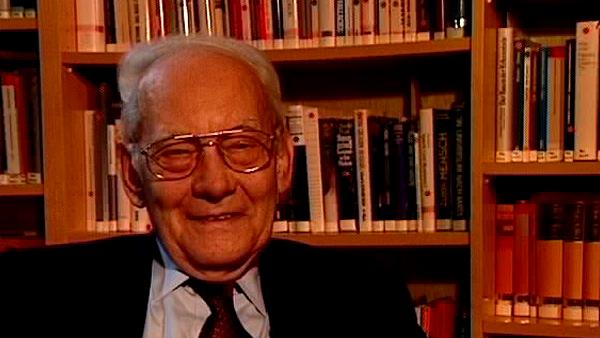NEXT STORY

The complexity of a sequence of nucleotides
RELATED STORIES

NEXT STORY

The complexity of a sequence of nucleotides
RELATED STORIES


|
Views | Duration | |
|---|---|---|---|
| 61. Extending Darwinian theory to molecules | 158 | 01:31 | |
| 62. The difference between my theory and classical genetic theory | 227 | 02:31 | |
| 63. The fitness landscape | 231 | 02:18 | |
| 64. The complexity of a sequence of nucleotides | 122 | 03:37 | |
| 65. Population and mutation | 118 | 01:22 | |
| 66. The progress of evolution | 122 | 02:47 | |
| 67. Finding a ridge in sequence space | 108 | 01:25 | |
| 68. Low and high dimensional landscapes | 116 | 02:47 | |
| 69. Peter Schuster's concept of sequence space and shape space | 133 | 04:34 | |
| 70. The space of mutants | 109 | 01:27 |


Now here we come to the fitness landscape. The fitness landscape was an expression coined by Sewall Wright, one of the classical neo-Darwinian theorists. So we could ask again, 'What is new with fitness landscape?' Well fitness landscape was really seen as a landscape. Perhaps it's a good example. Let's look at the landscapes on earth. Think of an island. I think Benoit Mandelbrot has treated such an example in his book on fractals. Think of an island which is a mountainous countryside, and ask the question, 'How does a raindrop, falling on that island... will reach the ocean?' Well you would say, 'Well, it will run down wherever there is a gradient on mountains, but then it will soon be in a basin and the basin has to be filled up before the raindrops can go on in running down'. Now the picture you have is usually a one-dimensional picture. You see a cut through that landscape and you see it runs down, now fills up the basin, then it can run down further and so on. But our landscapes on earth are not one-dimensional. The surface of earth is two-dimensional, so a basin has certain heights in it and the raindrop will always come out at the lowest part. So if you take the one-dimensional cut through the landscape as an average, you don't have to fill the basin completely because a raindrop runs out at the lowest part of the rim of the basin, and therefore on average you don't have to fill it up. And now people have studied this if you go to higher dimension. If you go to a three-dimensional or four-dimensional, five, finally to a Hilbert space of almost infinite number of dimensions. That means the level can come lower and lower and lower and in the limit of the Hilbert space every raindrop will reach the ocean.
Nobel Prize winning German biophysical chemist, Manfred Eigen (1927-2019), was best known for his work on fast chemical reactions and his development of ways to accurately measure these reactions down to the nearest billionth of a second. He published over 100 papers with topics ranging from hydrogen bridges of nucleic acids to the storage of information in the central nervous system.
Title: The fitness landscape
Listeners: Ruthild Winkler-Oswatitch
Ruthild Winkler-Oswatitsch is the eldest daughter of the Austrian physicist Klaus Osatitsch, an internationally renowned expert in gas dynamics, and his wife Hedwig Oswatitsch-Klabinus. She was born in the German university town of Göttingen where her father worked at the Kaiser Wilhelm Institute of Aerodynamics under Ludwig Prandtl. After World War II she was educated in Stockholm, Sweden, where her father was then a research scientist and lecturer at the Royal Institute of Technology.
In 1961 Ruthild Winkler-Oswatitsch enrolled in Chemistry at the Technical University of Vienna where she received her PhD in 1969 with a dissertation on "Fast complex reactions of alkali ions with biological membrane carriers". The experimental work for her thesis was carried out at the Max Planck Institute for Physical Chemistry in Göttingen under Manfred Eigen.
From 1971 to the present Ruthild Winkler-Oswatitsch has been working as a research scientist at the Max Planck Institute in Göttingen in the Department of Chemical Kinetics which is headed by Manfred Eigen. Her interest was first focused on an application of relaxation techniques to the study of fast biological reactions. Thereafter, she engaged in theoretical studies on molecular evolution and developed game models for representing the underlying chemical proceses. Together with Manfred Eigen she wrote the widely noted book, "Laws of the Game" (Alfred A. Knopf Inc. 1981 and Princeton University Press, 1993). Her more recent studies were concerned with comparative sequence analysis of nucleic acids in order to find out the age of the genetic code and the time course of the early evolution of life. For the last decade she has been successfully establishing industrial applications in the field of evolutionary biotechnology.
Tags: neo-Darwinism, fractals, Hilbert space, Sewall Green Wright, Benoit B Mandelbrot, David Hilbert
Duration: 2 minutes, 19 seconds
Date story recorded: July 1997
Date story went live: 24 January 2008